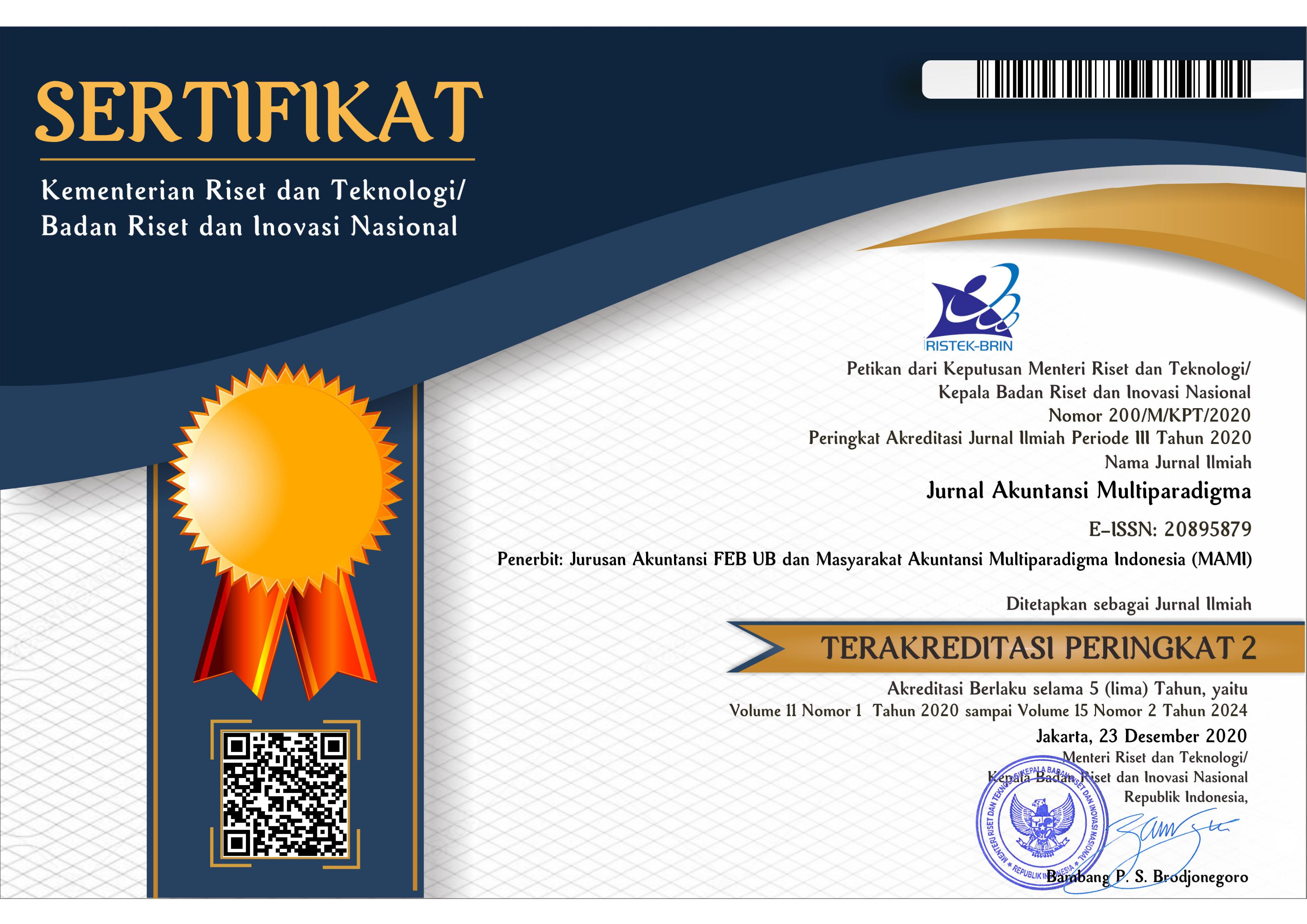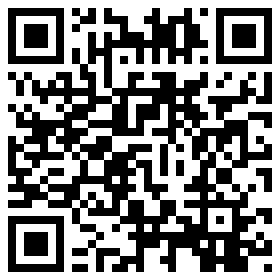BUDAYA TRI HITA KARANA DALAM MODEL UTAUT
Abstract
Abstrak: Budaya Tri Hita Karana dalam Model UTAUT. Penelitian ini menggali definisi dan indikator pertanyaan yang mewakili budaya Tri Hita Karana (THK) dalam model Unified Theory of Acceptance and Use of Technology (UTAUT). Penelitian ini menggunakan pendekatan studi literatur (untuk menggali definisi) dan uji lapangan (untuk memvalidasi). Penelitian ini menemukan Faktor Sosial Budaya (FSB) sebagai indikator baru dalam model UTAUT. FSB didefinisikan sebagai persepsi individu mengenai sesuatu yang dianggap penting (pengadopsian, pemanfaatan, dan penggunaan Sistem Informasi Akuntansi). FSB dipengaruhi oleh orang penting yang ada di sekitar, pemikiran individu, dan tingkat spiritualitas.
Abstract: Tri Hita Karana Culture in UTAUT Model. This study explores the definitions and indicators of questions that represent Tri Hita Karana (THK) culture in Unified Theory of Acceptance and Use of Technology (UTAUT) model. This study uses literature study (to dig definition) and field test (to validate). This study finds Social Factor Culture (FSB) as a new indicator in UTAUT model. FSB is defined as perceptions of individuals that is considered important (adoption, utilization, and use of Accounting Information Systems). FSB is influenced by the important people around, individual thinking, and the level of spirituality.
Keywords
Full Text:
PDFReferences
Abrahao, R. S., Moriguchi, S. N., & Andrade, D. F. (2016). Intention of Adoption of Mobile Payment: An Analysis in the Light of the Unified Theory of Acceptance and Use of Technology (UTAUT). RAI Revista de Administração e Inovação, 13(3), https://doi.org/10.1016/j.rai.2016.06.003
Ahlan, A. R., & Ahmad, B. I. (2015). An Overview of Patient Acceptance of Health Information Technology in Developing Countries: A Review and Conceptual model. International Journal of Information Systems and Project Management, 3(1), 29–48. https://doi.org/10.12821/ijispm030102
Al-Gahtani, S. S., Hubona, G. S., & Wang, J. (2007). Information Technology ( IT ) in Saudi Arabia: Culture and the Acceptance and Use of IT. Information & Management, 44, 681–691. https://doi.org/10.1016/j.im.2007.09.002
Al-Qesi, K., & Hegazy, A. (2015). Consumer Online Behaviour: A perspective on Internet Banking Usage in Three Non-western Countries. Procedia Economics and Finance, 23, 386-390. https://doi.org/10.1016/S2212-5671(15)00347-0
Alewine, H. C., Allport, C. D., & Shen, W. C. M. (2016). How Measurement Framing and Accounting Information System Evaluation Mode Influence Environmental Performance Judgments. International Journal of Accounting Information Systems, 23, 28-44. https://doi.org/10.1016/j.accinf.2016.10.002
Amaliah, T. H. (2016). Nilai-Nilai Budaya Tri Hita Karana dalam Penetapan Harga Jual. Jurnal Akuntansi Multiparadigma, 7(2), 189-206. http://dx.doi.org/10.18202/jamal.2016.08.7016
Ariyanto, D., Subroto, B., Purnomosidhi, B., & Rosidi. (2014). Information and Knowledge Management Does the Balinese Tri Hita Karana Culture Affect the Adoption and Usage of Information Technology Systems? Information and Knowledge Management, 4(9), 150–161.
Azwar, S. (2012). Reliabilitas dan Validitas. Yogyakarta: Purtaka Belajar.
Bandyopadhyay, K., & Fraccastoro, K. A. (2007). The Effect of Culture on User Acceptance of Information Technology. Communications of the Association for Information Systems, 19, 522–543.
Bradford, M., & Gerard, G. J. (2015) Using Process Mapping to Reveal Process Redesign Opportunities during ERP Planning. Journal of Emerging Technologies in Accounting, 12(1), 169-188. https://doi.org/10.2308/jeta-51253
Budhiastra, I. M. M. (2016). An Essay on Karma Karana: A Notion on Restructuring the Bali Hospitality and Service Industry by Re-establishing the Concepts of Tri Hita Karana and Karmaphala. Research in Hospitality Management, 6(2), 219-224. https://doi.org/10.1080/22243534.2016.1253294
Catchpowle, L., & Smyth, S. (2016). Accounting and Social Movements: An Exploration of Critical Accounting Praxis. Accounting Forum, 40(3), 220-234. https://doi.org/10.1016/j.accfor.2016.05.001
Chang, H., Ittner, C. D., & Paz, M. T. (2014). The Multiple Roles of the Finance Organization: Determinants, Effectiveness, and the Moderating Influence of Information System Integration. Journal of Management Accounting Research, 26(2), 1-32. https://doi.org/10.2308/jmar-50802
Chauhan, S., & Jaiswal, M. (2016). Determinants of Acceptance of ERP Software Training in Business Schools: Empirical Investigation Using UTAUT Model. The International Journal of Management Education, 14(3), 248-262. https://doi.org/10.1016/j.ijme.2016.05.005
Choi, Y. S., Seo, M., Scott, D., & Martin, J. J. (2010). Validation of the Organizational Culture Assessment Instrument: An Application of the Korean Version. Journal of Sport Management, 24, 169–189.
Church, K. S., Schmidt, P. J., & Smedley, G. (2016). Casey's Collections: A Strategic Decision-Making Case Using the Systems Development Lifecycle—Planning and Analysis Phases. Journal of Emerging Technologies in Accounting, 13(2), 231-245. https://doi.org/10.2308/jeta-51472
Cieslewicz, J. K. (2016). Collusive Accounting Supervision and Economic Culture. Journal of International Accounting Research, 15(1), 89-108. https://doi.org/10.2308/jiar-51181
Coyne, J. G.,Coyne, E. M., & Walker, K. B. (2016). A Model to Update Accounting Curricula for Emerging Technologies. Journal of Emerging Technologies in Accounting, 13(1), 161-169. https://doi.org/10.2308/jeta-51396
Decman, M. (2015). Modeling the Acceptance of E-learning in Mandatory Environments of Higher Education: The Influence of Previous Education and Gender. Computers in Human Behavior, 49, 271-281. https://doi.org/10.1016/j.chb.2015.03.022
Dillard, J., Yuthas, K., & Baudot, L. (2016). Dialogic Framing of Accounting Information Systems in Social and Environmental Accounting Domains: Lessons from, and for, Microfinance. International Journal of Accounting Information Systems, 23, 14-27. https://doi.org/10.1016/j.accinf.2016.10.001
Gonzalez, G. C., Sharma, P. N., & Galletta, D. (2012). Factors Influencing the Planned Adoption of Continuous Monitoring Technology. Journal of Information Systems, 26(2), 53-69. https://doi.org/10.2308/isys-50259
Gupta, B. (2011). A Comparative Study of Organizational Strategy and Culture Across Industry. Benchmarking: An International Journal, 18(4), 510–528. https://doi.org/10.1108/14635771111147614
Hannan, R. L., McPhee, G. P., Newman, A. H., & Tafkov, I. D. (2013). The Effect of Relative Performance Information on Performance and Effort Allocation in a Multi-Task Environment. The Accounting Review, 88(2), 553-575. https://doi.org/10.2308/accr-50312
Harris, L., & Mardiyati, E. (2013). Prestasi Belajar Mahasiswa Akuntansi atas Sistem Aplikasi Enterprise Resource Planning. Jurnal Akuntansi Multiparadigma, 4(1), 55-74
Hartono, J. (2007). Sistem Informasi Keperilakuan. Yogyakarta: Andi Offset.
Hartono, J., & Abdillah, W. (2009). Konsep dan Aplikasi PLS (Partial Least Square) untuk Penelitian Empiris. BPFE: Yogyakarta.
Hew, T. S., & Kadir, S. L. S. A. (2016). Predicting the Acceptance of Cloud-based Virtual Learning Environment: The Roles of Self Determination and Channel Expansion Theory. Telematics and Informatics, 33(4), 990-1013. https://doi.org/10.1016/j.tele.2016.01.004
Hofstede, G. (2010). Cultures and Organizations: Software of the Mind. McGraw-Hill, New York.
Hou, C. (2012). Examining the Effect of User Satisfaction on System Usage and Individual Performance with Business Intelligence Systems: An Empirical Study of Taiwan’s Electronics Industry. International Journal of Information Management, 11(37), 1–14. https://doi.org/10.1016/j.ijinfomgt.2012.03.001
Janvrin, D. J., Lim, J. H., & Peters, G. F. (2015). The Perceived Impact of Journal of Information Systems on Promotion and Tenure. Journal of Information Systems, 29(1), 73-93. https://doi.org/10.2308/isys-50963
Janvrin, D. J., Pinsker, R. E., & Mascha, M. F. (2013). XBRL-Enabled, Spreadsheet, or PDF? Factors Influencing Exclusive User Choice of Reporting Technology. Journal of Information Systems, 27(2), 35-49. https://doi.org/10.2308/isys-50569
Khairi, M. S., & Baridwan, Z. (2015). An Empirical Study on Organizational Acceptance Accounting Information Systems in Sharia Banking. The International Journal of Accounting and Business Society, 23(1), 97–121.
Lianta, M. A. S., & Baridwan, Z. (2011). Faktor-Faktor Sikap yang Mempengaruhi Minat Penggunaan Internet Banking. Jurnal Akuntansi Multiparadigma, 2(2), 310-326.
Loo, W. H., Yeow, P. H. P., & Chong, S. C. (2009). User Acceptance of Malaysian Government Multipurpose Smartcard Applications. Government Information Quarterly, 26(2), 358–367. https://doi.org/10.1016/j.giq.2008.07.004
López, O. L., & Hiebl, M. R. W. (2015). Management Accounting in Small and Medium-Sized Enterprises: Current Knowledge and Avenues for Further Research. Journal of Management Accounting Research, 27(1), 81-119. https://doi.org/10.2308/jmar-50915
Martins, C., Oliveira, T., & Popovic, A. (2014). Understanding the Internet Banking Adoption: A Unified Theory of Acceptance and use of Technology and Perceived Risk Application. International Journal of Information Management, 34(1), 1-13. https://doi.org/10.1016/j.ijinfomgt.2013.06.002
Meiranto, W. (2011). Kajian Online Sistem Informasi BRI (BRINETS): Pedekatan Technology Acceptance Model (TAM). Jurnal Akuntansi Multiparadigma, 2(1), 91-103.
Mohammadi, H. (2015). Investigating Users’ Perspectives on E-learning: An Integration of TAM and IS Success Model. Computers in Human Behavior, 45, 359–374. https://doi.org/10.1016/j.chb.2014.07.044
Moore, G. C., & Benbasat, I. (1991). Development of an Instrument to Measure the Perception of Adopting an Information Technology Innovation. Information Systems Research, 2(3), 192–222.
Nolder C., & Riley, T. J. (2014). Effects of Differences in National Culture on Auditors' Judgments and Decisions: A Literature Review of Cross-Cultural Auditing Studies from a Judgment and Decision Making Perspective. AUDITING: A Journal of Practice & Theory, 33(2), 141-164. https://doi.org/10.2308/ajpt-50657
Palanisamy, R. (2008). Organizational Culture and Knowledge Management in ERP Implementation: An Empirical Study. The Journal of Computer Information Systems, 48(2), 100–120.
Partala, T., & Saari, T. (2015). Understanding the Most Influential User Experiences in Successful and Unsuccessful Technology Adoptions. Computers in Human Behavior, 53, 381–395. https://doi.org/10.1016/j.chb.2015.07.012
Pinsker, R. E., & Felden, C. (2016). Professional Role and Normative Pressure: The Case of Voluntary XBRL Adoption in Germany. Journal of Emerging Technologies in Accounting, 13(1), 95-118. https://doi.org/10.2308/jeta-51367
Rahayu, S., Yudi, Sari, D. P. (2016). Makna Biaya pada Ritual Ngaturang Canang Masyarakat Bali. Jurnal Akuntansi Multiparadigma, 7(3), 382-398. http://dx.doi.org/10.18202/jamal.2016.12.7028
Ramstedt, M. (2014). Discordant Temporalities in Bali's New Village Jurisdictions. The Journal of Legal Pluralism and Unofficial Law, 46(4), 60-78. https://doi.org/10.1080/07329113.2014.893722
Schermann, M., Wiesche, M., & Krcmar, H. (2012). The Role of Information Systems in Supporting Exploitative and Exploratory Management Control Activities. Journal of Management Accounting Research, 24(1), 31-59. https://doi.org/10.2308/jmar-50240
Sonhaji. (2017). Sistem Informasi Akuntansi Manajemen Syariah untuk Organisasi Islam. Jurnal Akuntansi Multiparadigma, 8(1), 47-62. http://dx.doi.org/10.18202/jamal.2017.04.7039
Sudana, I. P. (2016). Sustainable Development, Kebijakan Lokal Bali, dan Emancipatory Accounting. Jurnal Akuntansi Multiparadigma, 7(2), 207-222. http://dx.doi.org/10.18202//jamal.2016.08.7017
Sumak, B., & Sorgo, A. (2016). The Acceptance and Use of Interactive Whiteboards among Teachers: Differences in UTAUT Determinants between Pre- and Post-adopters. Computers in Human Behavior, 64, 602-620. https://doi.org/10.1016/j.chb.2016.07.037
Surya, I. B. K., Thoyib, A., Fatchan, A., & Rahayu, M. (2014). Tri Hita Karana Culture Effect on Company Performance, Leadership and Organizational Commitment (Studies an Regional Water Company in Bali Province). International Journal of Business and Management Invention, 3(6), 13–22.
Thatcher, S. M. B., Foster, W., & Zhu, L. (2006). B2B E-commerce Adoption Decisions in Taiwan: The Interaction of Cultural and Other Institutional Factors. Electronic Commerce Research and Application, 5, 92–104. https://doi.org/10.1016/j.elerap.2005.10.005
Tosuntas, S. B., Karadag, E., & Orhan S. (2015). The Factors Affecting Acceptance and Use of Interactive Whiteboard within the Scope of FATIH Project: A Structural Equation Model based on the Unified Theory of Acceptance and Use of Technology. Computers & Education, 81, 169-178. https://doi.org/10.1016/j.compedu.2014.10.009
Trigo, A., Belfo, F., & Estebanez, R. F. (2014). Accounting Information Systems: The Challenge of the Real-time Reporting. Procedia Technology, 16, 118-127. https://doi.org/10.1016/j.protcy.2014.10.075
Utama, D. (2016). Pencarian Bentuk Penelitian untuk Mengaktualisasikan Prinsip Counter Accounting. Jurnal Akuntansi Multiparadigma, 7(3), 462-484. http://dx.doi.org/10.18202/jamal.2016.12.7033
Venkatesh, V., Thong, J. Y., & Xu, X. (2012). Consumer Acceptance And Use Of Information Technology: Extending The Unified Theory. MIS Quarterly, 36(1), 157–178.
Venkatesh, V., & Zhang, X. (2010). Unified Theory of Acceptance and Use of Technology: US vs China. Journal of Global Information Technology Management, 13(1), 5–27. https://doi.org/10.1080/1097198X.2010.10856507
Wiana, I. K. 2007. Tri Hita Karana Menurut Konsep Hindu. Surabaya: Paramita.
DOI: http://dx.doi.org/10.18202/jamal.2017.08.7062
Refbacks
- There are currently no refbacks.
Copyright (c) 2017 Dodik Ariyanto, Maria M Ratna Sari, Ni Made Dwi Ratnadi

This work is licensed under a Creative Commons Attribution-NonCommercial 4.0 International License.

















